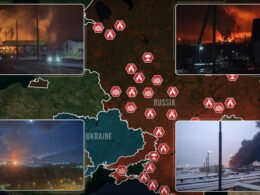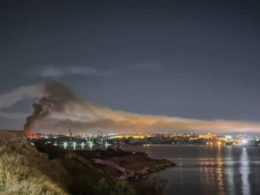Today there are a lot of updates from the Kurakhove direction. Here, in a shocking turn of events, Russian forces have launched a series of high-casualty "meat wave" assaults on the town of Vodyane, near Vuhledar.

These devastating attacks, with soldiers advancing over the bodies of their fallen comrades, have left military analysts questioning how long Russia can sustain such a costly and desperate strategy before once again rolling back and nullifying their gains.
Russian strategy shift
Russian forces have altered their approach in their renewed effort to capture Vuhledar. Instead of relying on direct frontal assaults as they did before, they are now attempting to encircle the town, launching coordinated offensives from the south and northeast.
The Russian strategy for the northern pincer hinges on crossing the T0532 highway and capturing the town of Vodyane. Once they establish fortified positions there, the plan is to advance southward toward the South Donbas coal mine. Russian commanders believe that seizing control of this key facility would significantly boost their chances of finally taking Vuhledar—a strategic objective that has remained out of reach for over two and a half years.

Recent geolocated footage has captured a series of intense and costly Russian assaults on Vodyane. In one particularly disastrous attempt, around ten motorcycles advanced from the northern flank of the Vuhledar front. This tactic, previously used by Russian forces in other sectors with often catastrophic outcomes due to the lack of protection for the riders, underscores their continued reliance on high-risk strategies despite repeated failures.
Even more disturbing footage captures the grim continuation and conclusion of this ill-fated motorcycle assault. The images reveal a Russian "meat wave" attack, with dozens of soldiers advancing under relentless mortar fire. Russian troops are seen literally marching over the bodies of their fallen comrades, showcasing the brutal nature of these saturation tactics.

Ukrainian soldiers report that the relentless, infantry-heavy assaults enable small groups of surviving Russian troops to make incremental advances, as the sheer volume of attackers makes it difficult to eliminate them all. Survivors from the initial waves regroup in tree lines and small dugouts.
Once enough have gathered, they push forward again. While Ukrainian forces focus on neutralizing the nearest threats, Russian reinforcements continue to bolster the lines behind. This tactic allows Russian forces to inch closer to the village, advancing tree line by tree line, and eventually infiltrating buildings and hiding in basements until another critical mass is formed. This slow, high-casualty strategy explains Russia's gradual, albeit costly, advance toward Vodyane.
Vodyane and the South Donbas coal mine
These two pieces of evidence explain how, according to recent reports and visual confirmation, Russian forces have managed to penetrate the northern part of Vodyane through relentless saturation attacks. Geolocated images now confirm that Russian troops have established positions in the northern residential area. In the background of these images, the auxiliary buildings of the South Donbas coal mine and its waste heap are clearly visible, further validating their foothold in this critical zone.

Trending Now
Following the capture of Vodyane, the next strategic objective for Russian forces is the South Donbas coal mine. If we look at the topographic map, we can see that Vodyane lies in the lowlands, whereas the coal mine is located on the high ground. This elevation, combined with the presence of tall, robust buildings offering concealed defensive positions, provides a significant advantage for Ukrainian defenders—an advantage they lacked in Vodyane.

The contrast in terrain and defensive infrastructure suggests that Russian forces will likely face far greater resistance and must endure the loss of many more soldiers before they can hope to seize the coal mine. The elevated and fortified nature of the area makes it a much more formidable challenge compared to the lowlands recently overtaken.
This is why, despite their localized gains, military analysts argue that Russian forces are unlikely to maintain the initiative across eastern Ukraine indefinitely. The mounting pressure from intensified offensives in Donetsk Oblast, combined with the ongoing strain from Ukraine's incursions into Kursk Oblast, is expected to force Russian offensive operations to culminate sooner than their military command intends. These overlapping challenges could significantly weaken Russia's ability to sustain its current momentum.
Signs of operational exhaustion
Overall, while Russian forces have managed to advance on Vodyane through relentless saturation attacks, sacrificing a staggering number of personnel, the sustainability of these tactics is increasingly in doubt. Signs of operational exhaustion are already evident in the Pokrovsk direction, where Russian troops have depleted their reserves at an unsustainable rate and have failed to make any territorial gains over the past week. This stagnation in Pokrovsk highlights the limitations of Russia's current offensive strategy and suggests that similar culmination points could emerge in other sectors, including Vuhledar.
The heavily fortified nature of their next objectives, combined with difficult terrain, indicates that sustaining this momentum will come at an even higher cost in manpower and resources. With pressure building on multiple fronts, Russian command may find their offensive capabilities stretched to the breaking point sooner than expected. This potential weakening could open the door for Ukrainian counterattacks in the weeks ahead.
In our regular frontline report, we pair up with the military blogger Reporting from Ukraine to keep you informed about what is happening on the battlefield in the Russo-Ukrainian war.





